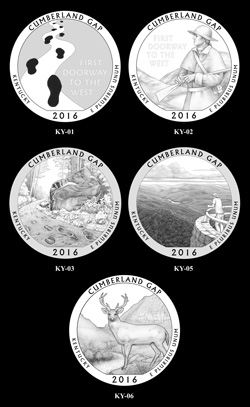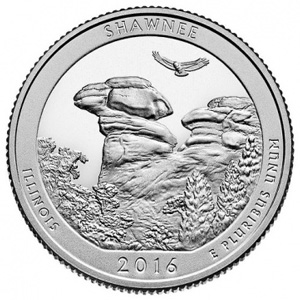
Cumberland Gap Quarter design
On July 22, 2015, the U.S. Mint announced the final design for the Cumberland Gap National Historical Park quarters. The reverse shows a frontiersman looking to the west, along with the inscription first doorway to the west.
The inscriptions on the coin’s reverse include the name of the site: cumberland gap, the location of the site: kentucky, the year of issue: 2016, and the motto: e pluribus unum.
This handsome quarter is a perfect match for the 2001 Statehood quarter, which also featured Kentucky, the park’s home state. As the 32nd in the series overall, the Cumberland quarter will be followed by designs honoring Harpers Ferry, Theodore Roosevelt and Fort Moultrie parks.
February 24, 2016 – 10:23 am

Candidate designs for the Cumberland Gap National Historic Park quarter
In late 2014, both the Citizens Coinage Advisory Committee and the Commission of Fine Arts reviewed several candidate designs for the reverse of the 2016 Cumberland Gap National Historic Park quarter.
The CCAC was divided among three designs. The first showed an explorer, with the inscription first doorway to the west. Another featured an up-close view of a trail within the park, while the third displayed a larger view of the Gap with a deer in the foreground. The CFA gave its support to the wider view of Cumberland Gap, with the up-close view of the deer.
Located in Kentucky, Cumberland Gap National Historic Park is filled with scenic beauty and panoramic views that are enjoyed by all who visit.
February 15, 2016 – 12:47 pm

Cumberland Gap National Historical Park, Kentucky
In the early days of American history, a natural break in the Appalachian Mountains opened land west of that chain to settlers of present-day Kentucky. This began in 1775, when Daniel Boone blazed a trail through the Cumberland Gap to create the Wilderness Road. It’s thought that between 1775-1810, an estimated 300,000 people crossed the Gap to settle lands west of the Appalachians! Later, as the Civil War gripped the nation, both the North and the South considered this area to be a strategic foothold.
Today, the region’s rich history and natural beauty draw visitors in. From guided tours and historic settlements, to camping, hiking, sightseeing and more – Cumberland Gap holds something for everyone!
Learn more about Cumberland Gap National Historical Park.
February 12, 2016 – 7:42 am
The new Shawnee National Forest quarter, 31st issue of the series and the first design for 2016, is now in circulation. On February 4, 2016, the official launch ceremony for the new Shawnee quarter took place in the gymnasium of Southeastern Illinois College in Harrisburg, IL.
After the ceremony, a coin exchange was held where attendees were able to get $10 rolls of the new quarters at face value. This issue features an up-close view of Camel Rock, with a red-tailed hawk soaring above. Add the new Shawnee quarters to your collection now.
February 1, 2016 – 11:24 am

Shawnee National Forest quarter design
On July 22, 2015, the U.S. Mint announced the final design for the Shawnee National Forest quarters. The reverse shows an up-close view of Camel Rock in Garden of the Gods, with a red-tailed hawk soaring above.
The inscriptions on the coin’s reverse include the name of the site: shawnee, illinois, the year of issue: 2016, and the motto: e pluribus unum.
This handsome quarter is a perfect match for the 2003 Statehood quarter, which also featured Illinois, the forest’s home state. As the 31st in the series overall, the Shawnee quarter will be followed by designs honoring Cumberland Gap, Harpers Ferry, Theodore Roosevelt and Fort Moultrie parks.




